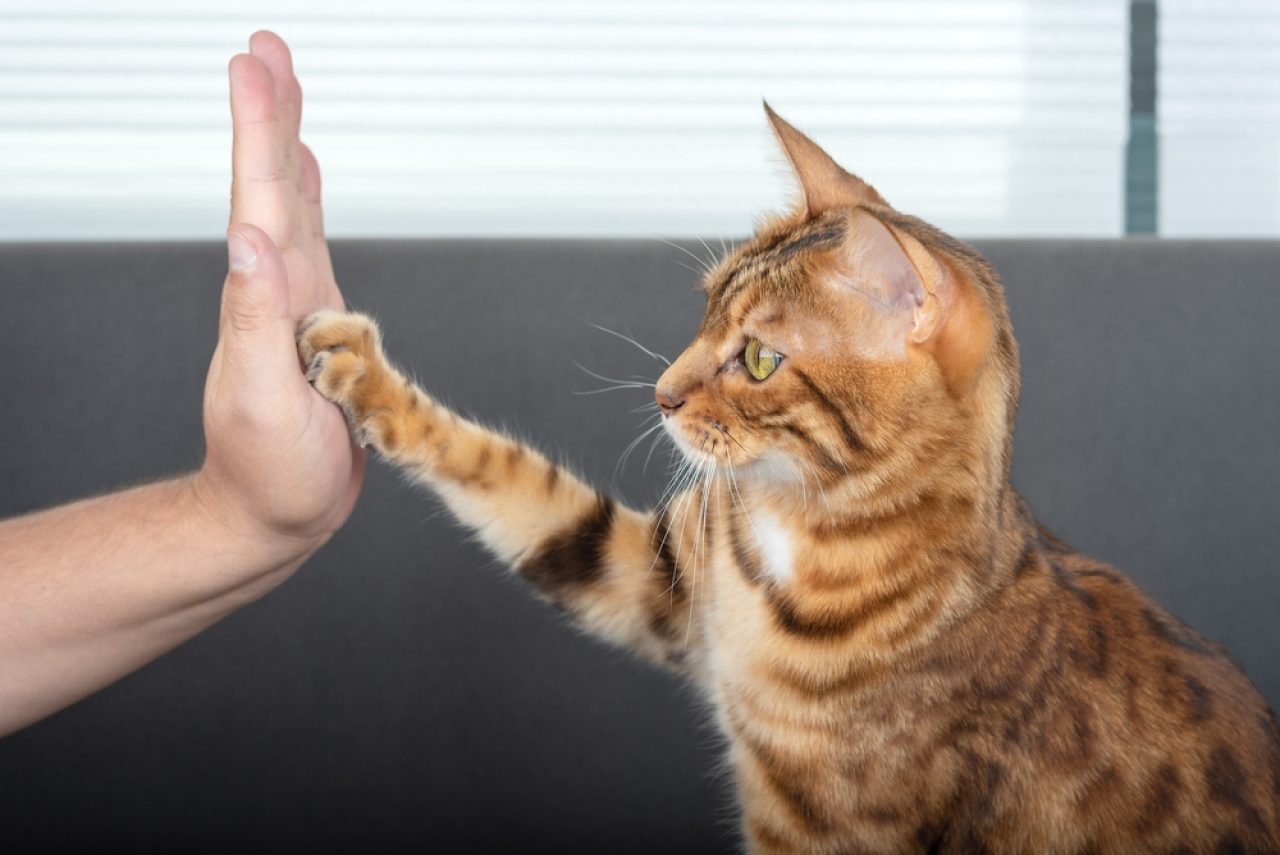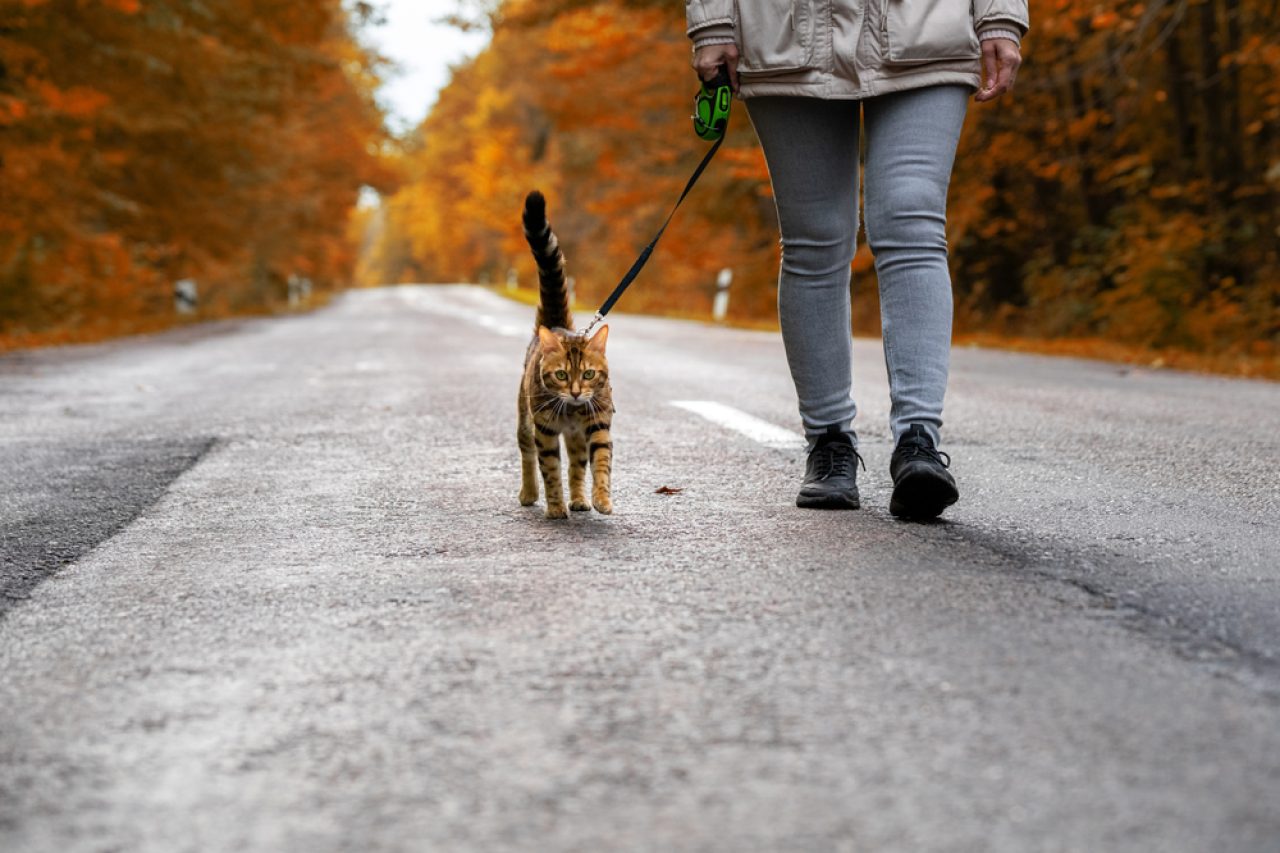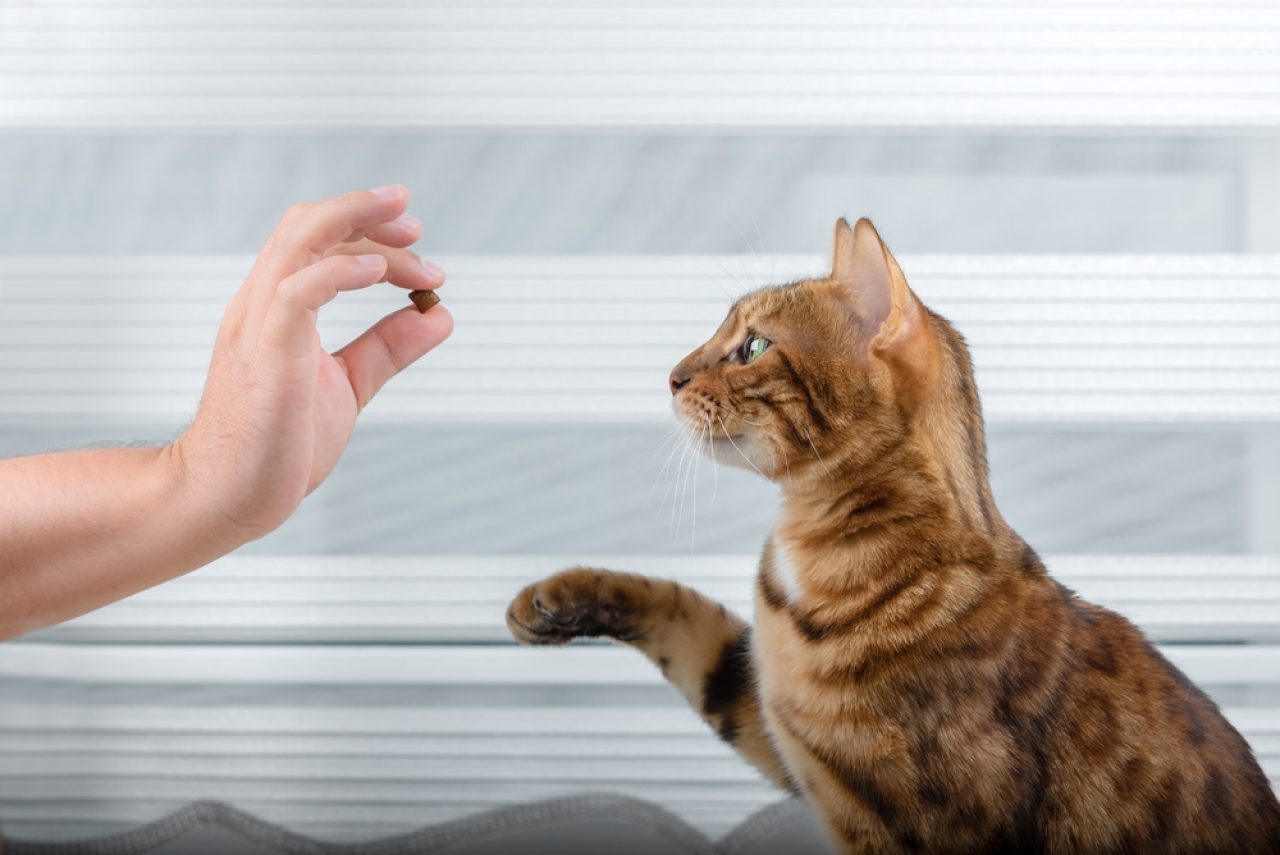📖 Table of Content:
Having the reputation of mischievous little fluff balls, people believe Bengals are one of the most difficult breeds to train. Their wild-like nature not only comes from their Asian leopard cat ancestors but their intellect as well. So, how to train a Bengal cat then?
These felines are known as one of the smartest cat breeds which makes them easier to train than most! People often compare them to dogs when it comes to their willingness to learn tricks. But despite their eagerness to learn new skills, there are a few things that set them apart from canines.
So, regardless of if you’re looking for tips on how to teach your kitty new tricks, fix bad behavior, or start leash training, keep reading as we cover all of it! (We’ll also show you some fun basic tricks you can start with!).
How to train a Bengal cat: 6 tips to follow
When training your Bengal cat and teaching her tricks, there are a few main tips to keep in mind. Although different cats have different personalities, these tips are applicable to all felines! Always keep your kitty’s personal needs in mind and adjust training accordingly.
1. Who doesn’t like food?!
The unskippable part of any animal’s training. Treats! Positive encouragement and rewards are by far the most efficient way to teach your furball any trick. Always give your Bengal cat some kibble to help her associate good things with desired behavior when training.
Felines are most motivated by food. So, to make the training even more efficient, consider doing it before mealtime! (Just don’t give them too much, you don’t want an unhealthy kitty!) Choosing some healthy and delicious treats is the way to go.
2. Click for that trick!
One of the most commonly used tools to help a feline learn more quickly is a clicker. Every time your Bengal cat does the trick you’re trying to teach her, use your clicker along with that treat! She’ll associate the three together and the training will move along much faster.
Although pretty useful, a clicker is definitely not necessary. Your voice will do just fine and can even make it easier to communicate with your Bengal. Who’s carrying a clicker around all the time? Ultimately, the choice is yours.
3. Keep the sessions short
Bengal cats have an unmatched curiosity and intelligence which doesn’t help with their attention spans. They tend to get bored pretty quickly and long training sessions will tire them out. That’s why you need to make sure to keep the sessions short and interesting!
Instead of long training sessions, include a lot of quick but consistent ones. Your fuzzy friend won’t be able to keep up with you for hours. A short but frequent sesh helps your cat maintain her interest and focus. Constant repeating will help them memorize things at a faster pace, too.
4. One trick at a time
How did you use to study in school? Would you revise constantly and take it one lesson at a time? Or were you one of those students who’d cram everything in one night? I was both and I always hated cramming whenever I’d do it.
My brain would stop working and I’d get frustrated and stressed. I’d forget even the things I knew and curse myself for not having better time management skills. I’d wish I had taken it one step at a time. Thankfully, you can now keep your kitty from making the same mistake.
So, how to train a Bengal cat properly? Teach her one trick at a time. Focus on just one thing until she gets the hang of it. Once she masters it, you can move on to the next trick. This way of training helps your Bengal cat memorize tricks faster without getting confused.
5. Start early, but not too early!
You’re probably familiar with the advice to start training your furry friend as soon as possible. You can’t teach an old dog- whoops, old cat new tricks, right? While that’s true, you shouldn’t start too early either.
Forcing your kitten to concentrate on training will only waste your time. Young fluff balls have only one thing on their mind and that’s playing and exploring their new surroundings. Spare yourself the wasted effort and wait until they grow a bit.
6. Have patience
Cats can be much more stubborn than dogs, especially Bengals. Despite being smarter than most dogs, your Bengal kitty will need more time to get the hang of tricks. For some felines, it’ll take days, but for some, it’ll be weeks or even months! Be patient and don’t give up.
In order to train a Bengal cat, you must be as stubborn as your feline and be twice as persistent. They will try to get to those treats without having to put in the effort to do tricks. You have to be stern and resist giving in to their cuteness. Look away from those pleading kitty eyes!
How to train a Bengal cat to use the litter box?
So, you just got a new kitty and you’re wondering how to litter train a Bengal cat? No one wants their carpets or furniture to smell like pee. Luckily, teaching your feline how to use a litter box is much easier than you think!
1. They already know
Chances are your kitten may instinctually know what to do! Cats are naturally drawn to litter boxes. They like to bury their feces, so when given a choice between a rug and some litter, guess what they’ll pick? Just getting a proper litter box is getting half of the job done!
2. Choosing the right box and litter
One of the reasons why your cat may be avoiding the litter box is that it’s not the right type. The box should be low without a cover on top. Felines don’t need privacy as humans do. The cover is just making them feel vulnerable when exiting the box.
As for the litter itself, it should be smooth and odorless. Though that scented sand might be making the cleaning process easier for you, think of your kitty. Her nose is much more sensitive than yours. And although crystal litter may look nicer, it makes it uncomfortable for your cat to finish her job.
3. Have multiple litter boxes
Felines are used to marking their territory in a large area. So, imagine how they might feel being constricted to one small box. So, to avoid them marking your sofa as their territory, it’s best to give them options. Keeping a few litter boxes around the house should do the trick.
Correcting bad behavior
Bengal cats don’t have a kitty moral code, so your furry friend definitely won’t be a saint. Unwanted behavior will certainly occur. And once it does, you’ll need to keep these things in mind! Following these tips will make sure your cat stops acting out while keeping her happy and healthy!
1. Call a vet
Some bad behaviors can often just be a call for help. An example can be spraying. If you’ve already litter-trained your Bengal cat and she starts spraying, it’s a sign to call a veterinarian. Spraying is often a sign of stress or other issues. So, before you start correcting her behavior, make sure your kitty is healthy.
2. Meeting a Bengal cat’s needs
Bengals are a very active breed that needs constant stimuli and attention. If you find your fuzz ball destroying furniture or chewing cables, consider getting a scratching post and some toys. Try to interact with them as much as possible or else they’ll be sure to interact with your sofa.
Keep in mind that cats require love and attention just as humans do. And you wouldn’t like to be stuck somewhere alone with nothing to do, right? Give your furry friend a chance to show you just how affectionate she can be!
There’s a wide variety of cat toys out there so experiment with different ones. Your cat is sure to fall in love with some of them! It’ll keep them happy and occupied until you have the time to snuggle them and stop them from destroying things.
3. Punishment leads to catastrophe!
I’m sure most of us grew up in households that taught us we’d be treated according to our actions. We reward good and give out punishments for bad behavior. There would be consequences for every time I broke something in the house, but does this work with felines?
Firstly, it’s important to remember that cats don’t feel guilty for their behavior. They can’t understand that they did something wrong. Punishing your cat will only make her feel unloved and can lead to serious trust issues.
Punishments vary in severity and so do their psychological consequences. They can tear a rift between you and your pet and traumatize her. Trauma and fear lead to other issues like spraying. You end up with more problems than you started with. So, how to stop unwanted behavior then?
4. Concentrate on the pawsitive, not negative
When your cat starts repeating some bad thing, it’s always best to focus on what they’re doing right. For example, if your feline develops a habit of stealing your food, always reward her for when she shows restraint instead of punishing her little act of theft.
Animals tend to react to and understand reward systems much better than punishments. They’re motivated by getting food and thus have every reason to adopt positive behavior. Punishments, on the other hand, they don’t understand at all.
Your little companion can’t comprehend why you’d treat her poorly. She doesn’t understand the concept of “correct” behavior. In her eyes, you’re just treating her unfairly. So, to avoid your fuzz ball being confused, focus on what she’s doing well.
How to leash train a Bengal cat?
By now, you must be thinking: “Leash training? I know you’ve compared them to dogs but really?!” And yes! It’s not only possible to walk your kitty like a dog, but it’s also recommended. Bengal cats are a very active breed that needs regular exercise and exposure to the outside.
While it’s possible to keep a Bengal as a housecat, it’s difficult to meet their requirements indoors. If you live in a house, letting your feline explore in the yard would be enough. However, helping your cat accept a leash is a great way to make that exploring safer.
A leash is also an excellent solution for people who live in apartments. I pass by an owner walking his kitty around the building every day and it’s the cutest thing ever. It’ll take some time for your cat to adjust to a leash but once she does, she’ll be eternally grateful!
1. Buying the right harness
When walking your furry friend on a leash, there are two things to keep in mind. One is that she might escape from the harness and the other is that it might hurt her. That’s why you need to be careful with what harness you choose.
Buy one that’s too tight and you might accidentally choke her. Buy one that’s too loose and she might wriggle out. Luckily, there’s an easy way to check if the harness is a good fit. You’ve got the right one if you can barely fit two fingers between it and your kitty.
This harness by OutdoorBengal is perfect for your furry friend since it’s been tested by Mia, the adventurous Bengal cat.
It’s also important to remember that you can’t walk your cat like a dog. You shouldn’t tug on the leash or try to guide her. Instead, allow her to guide you. And you should never walk her by her collar instead of a harness. Your little feline is gentle, and you can’t pull her like a dog.
2. Getting your Bengal cat accustomed to her leash
In order to leash train a Bengal cat, you need to be able to at least put it on, right? But that’s the thing- cats aren’t the best with new things. They’re skeptical of everything and putting something on them is even harder than simply introducing them to something new.
There are a few ways to get your fuzz ball used to a harness and leash. But, like everything else with this breed, it’ll take time. When thinking of how to train your Bengal cat, always keep this in mind. You need to be patient and try not to force anything onto your furball.
Leave it somewhere around the house where she can reach it. By giving your feline free access to the harness, she’ll learn not to fear it. She’ll sniff it, examine it, play with it. In time, she’ll get so used to it that she won’t even pay attention to it. Once she gets comfortable around it, you can move on to the next step.
Try petting her with it or just placing it onto a part of her body. This will help her relax and accept the feeling of the harness on her body. And once she’s completely unbothered by it, you can try putting it on. Aside from just giving her access to it, you can also surround it with treats!
3. Helping her keep the leash on
So, you managed to put the harness on, but your kitty still wants it off? It’s completely normal that even after all that training, your little wildcat still wants freedom. At this point of leash training, it’s important not to overdo it. Leave her harness on only for as long as she’s comfortable with it.
Let your kitty walk around the house in her harness until she’s completely okay with wearing it. Only then can you try taking her outside. And once you do, let her guide you. When she discovers the great outside, she’ll be grateful for the rest of her nine lives!
4. What if my cat still hates the harness?
Just like people, every feline has its own personality. They don’t all share the same likes and dislikes. It’s very possible for your Bengal to just hate harnesses. If that’s the case, don’t force her. Pushing her into something she hates will only frustrate you both.
There are still other ways to help your fuzzy companion get her exercise. Maximize your playtime with her or consider getting some interactive cat toys. Her health always comes first and that includes not stressing her out with something she hates.
Easy tricks you can teach your Bengal cat
Now that we’ve covered all the basics, here are some easy tricks you can start with! These are the baseline of other, more complex tricks. Once both you and your BFF (best fuzzy friend) get the hang of these, the rest will be simple!
Some breeds won’t ever be able to learn more than these few tricks. But, for Bengals, they are nothing but a warm-up! Once they start learning, they’ll be hungry for more. So, roll up your sleeves, get those treats ready and let’s get started!
1. Sit!
As any cat owner will say: “It’s a trick to make them stand, all they do is sit or sleep!”. So, the first thing we need to do is get them to stand up. The easiest way to do that is to call them or just wave a treat in front of them. Since we all know how much cats like to ignore us at times.
Once they’re up on their paws, it’s time to use the clicker. Or command them to sit. Then move the treat to their nose and above their head. This should automatically make them sit. When they do, you can hand them the treat.
Repeat this process until it’s enough for you to just give the command without moving the treat. Keep the treat in your hand, click or give the command, wait for them to sit, and reward them. Keep on repeating until you’re confident that your cat would now listen to you even without the treat.
2. Stand!
This trick should be even easier when training a Bengal cat. All you need to do is raise the treat a bit higher above their head. This will make them stand on their back legs so they can reach it. Then you can click or give them praise and give them the treat.
Be careful with the treat though! If you’re not holding it firmly enough, your kitty will definitely snatch it away. Felines are much faster than our reflexes, so you need to be alert. While learning tricks can be fun for your furball, she’d much rather just have the treat right away.
3. Spin!
It might take a while for your cat to fully understand this one, so move slowly. Hold the treat above her head and then move it in a circle. Make sure the circle is wide enough or your feline will just spin her head without moving her body.
Once you make a full circle, hold it up again so she stops or sits. Then you can reward her. When she learns to do it properly on one side, you can try the other one, too. Your arm might go numb from making constant circles in the air, but it’ll be worth it!
4. Shake hands!
This one can be a bit tricky because a lot of felines hate their paws being touched. In order to train a Bengal cat to shake hands, you need to help them get used to paw holding. To achieve this, try holding their paw for as long as they allow and immediately rewarding them.
If they get used to that, you can try holding out your hand and asking for their paw. They should connect the pieces and do as you ask. Then you can give them a treat again. (They might hate paw touches, but they get double the treats!)
Still, a lot of felines just won’t ever be okay with this trick. You should respect their feelings and avoid forcing them into anything. There are plenty of other fun tricks for you to try. What’s one failed trick compared to a hundred successful ones?
5. Lie down!
There are two ways to teach your furball how to lie down. It depends on what she understands better. However, in most cases, you will most likely need to use a combination of both. The best way to start this is with your cat already sitting, but she can stand, too.
The first way is to use a treat to guide her into the position. Move the treat in front of her nose and down to the ground. The problem with this method is that your feline may not always lie down. More often than not, she might just bend her knees and lower herself.
That’s where a clicker comes in handy. Every time she moves into position, click and give her a treat. The click can be replaced by praise. This method takes a bit longer since you’re waiting for her to lie down on her own. But in the end, anything that works is worth a try.
How to train a Bengal cat and do it successfully?
There’s a lot of work to do when it comes to training your kitty. It can be tiring and frustrating, especially when your little buddy just doesn’t understand something. But more than anything, there’s a lot of fun in training your feline.
The time you spend teaching her tricks and good behavior will turn into your fondest memories. Training builds a special bond and understanding between an owner and his fuzzball. We hope that our tips helped you understand your little friend just a bit better.
Hopefully, now you’ll know how to train a Bengal cat without any confusion. And the next time your kitty does something naughty, you’ll know exactly how to help her. You’ll know exactly what the problem is and what she needs!









